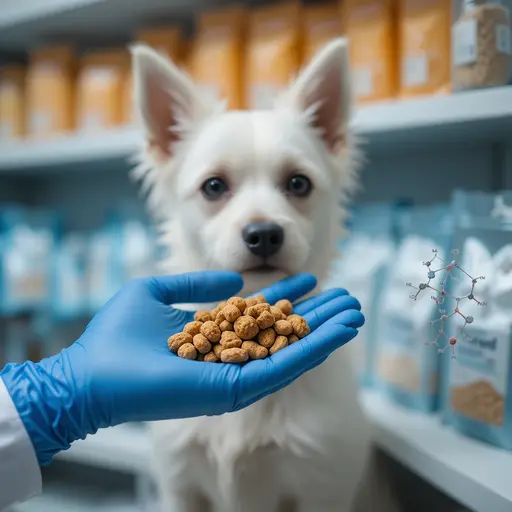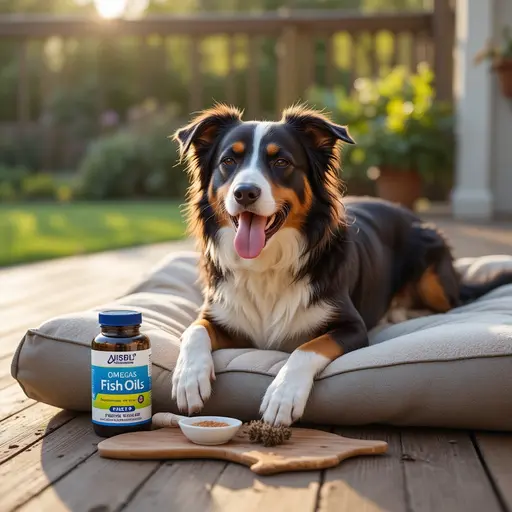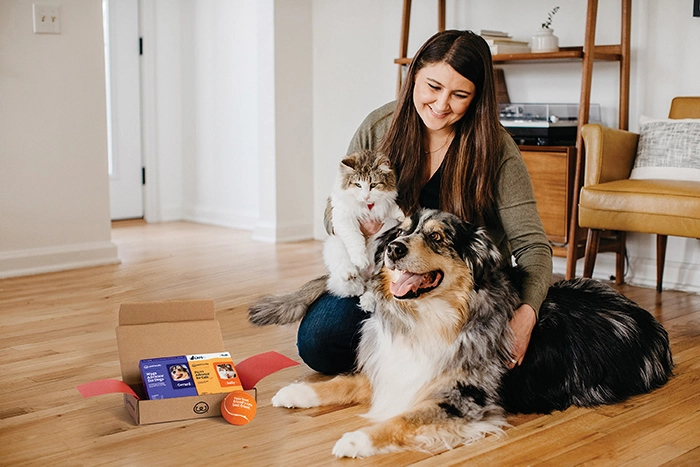Dog food allergy solutions involve identifying trigger ingredients through elimination diets, then transitioning to limited-ingredient, novel protein, or hydrolyzed protein formulas. Most dogs show improvement within 8–12 weeks on the right diet.
Food allergies affect up to 10% of dogs, causing chronic itching and digestive distress.
This guide breaks down science-backed solutions to help your dog recover comfortably and thrive long-term.
Understanding Dog Food Allergies
What Are Food Allergies?
Dog food allergies occur when the immune system mistakenly identifies a dietary protein as a threat, triggering defensive responses. Unlike environmental allergies, food allergies develop through repeated exposure over months or years.
The immune system produces antibodies against specific protein molecules, and subsequent exposures release histamines and inflammatory chemicals, causing symptoms.
The most important distinction: food allergies involve the immune system, while food intolerances involve digestion. True food allergies typically manifest as skin problems, while intolerances cause more immediate gastrointestinal upset without immune involvement.
Common Symptoms to Watch For
Dogs with food allergies rarely show symptoms after a single meal. Reactions build up gradually, making patterns difficult to spot without careful observation.
Skin-related signs:
- Non-stop itching, especially paws, ears, and rear
- Recurrent ear infections that don’t resolve with treatment
- Red, inflamed skin or hot spots
- Paw licking and chewing, often causing brown staining
- Hair loss and crusty patches
Digestive signs:
- Chronic diarrhea or loose stools
- Vomiting (less common but possible)
- Excessive gas and bloating
- Poor appetite or selective eating
Unique indicators:
Many allergic dogs scratch intensely for several hours after eating. Keep a simple log noting meal times and scratching episodes—this pattern helps vets distinguish food allergies from environmental triggers.
Food Allergies vs. Food Intolerance
This confusion delays proper treatment. Food intolerance means your dog’s digestive system cannot properly break down an ingredient, like lactose intolerance in humans.
Symptoms appear within hours and include gas, diarrhea, and stomach gurgling. The immune system stays uninvolved, so skin problems rarely occur.
Food allergies, conversely, trigger immune responses that primarily affect the skin and ears. The reaction time varies—some dogs react within 24 hours, others show symptoms after several days of exposure. This delayed response makes diagnosis challenging without structured elimination trials.
The Most Common Canine Food Allergens
Research shows proteins cause over 90% of food allergies in dogs. Carbohydrates rarely trigger true immune reactions despite marketing claims.
Top protein offenders:
- Beef – The most common allergen due to its prevalence in dog foods
- Dairy – Proteins like casein trigger reactions, not lactose
- Chicken – Widespread use makes it a frequent culprit
- Wheat – While less common, it can cause immune responses
- Soy – Contains complex proteins that challenge some immune systems
- Eggs – Particularly the protein in egg whites
- Lamb – Became problematic after trending as a “novel” protein
- Pork – Less common but documented in studies
Grains are often blamed unfairly. True grain allergies exist but represent a small fraction of cases. Grain-free diets help because they remove common protein carriers, not because grains themselves are inherently allergenic.

How Veterinarians Diagnose Food Allergies
The Elimination Diet Gold Standard
Blood and saliva tests for food allergies remain unreliable in dogs. The only scientifically validated method is a strict elimination diet lasting 8–12 weeks. This process requires patience but provides definitive answers.
Step-by-step elimination protocol:
- Choose a novel protein your dog has never eaten—kangaroo, rabbit, or bison work well
- Select a single carbohydrate source, like sweet potato or pumpkin
- Feed only these ingredients for 8–12 weeks—no treats, flavored medications, or table scraps
- Monitor symptoms weekly using a scoring system (itch level, stool quality, ear condition)
- If symptoms improve by at least 50%, you’ve likely identified the problem
- Challenge the diagnosis by reintroducing old proteins one at a time and watching for flare-ups
This method works because the immune system “forgets” allergens after prolonged avoidance. If symptoms return after reintroduction, you’ve found your trigger.
Critical success factors:
- Absolute compliance from all family members
- Switching to unflavored heartworm medication during the trial
- Using only approved treats (freeze-dried single-ingredient options)
What About Allergy Tests?
Many companies market blood, saliva, or hair tests promising to identify food allergies. Veterinary dermatologists consistently find these tests unreliable, often showing false positives for foods the dog has never consumed. The immune mechanisms tested don’t correlate with clinical symptoms.
Skin prick testing, effective for environmental allergies, fails for food allergies because the reaction occurs in the digestive tract, not the skin. Save your money for quality therapeutic diets instead.

Proven Dog Food Allergy Solutions
Limited Ingredient Diets (LID)
LIDs contain minimal components—typically one protein and one carbohydrate source plus essential vitamins and minerals. These formulas simplify ingredient tracing and reduce cross-contamination risks.
Why they work:
By removing dozens of potential triggers, LIDs give the immune system less to react against. Quality LIDs use protein sources uncommon in mainstream diets, decreasing prior sensitization.
Choosing a quality LID:
- Look for brands with dedicated manufacturing lines to prevent cross-contact
- Verify the protein appears as the first ingredient
- Check that the formula contains fewer than 10 total ingredients
- Avoid “with” labels—” dog food with chicken” may contain only 3% chicken
Transition tip: Switch gradually over 7–10 days, mixing increasing amounts of LID with the old food. Sudden changes stress the digestive system, potentially causing temporary symptoms that mask true allergy improvement.
Novel Protein Diets
Novel proteins are meats your dog has never eaten. The immune system cannot react to proteins it hasn’t encountered. Historically, vets recommended lamb, but its widespread use eliminated its novelty status.
Effective modern novel proteins:
- Kangaroo – Lean, highly digestible, and genuinely novel for most North American dogs
- Rabbit – Low-fat, single-source protein ideal for sensitive systems
- Venison – Rich in nutrients, but verify it’s not mixed with common proteins
- Alligator – Extremely novel but expensive and harder to source
- Duck – Works for dogs without prior poultry exposure
Critical caution:
Many “exotic protein” diets blend multiple meats. A duck formula containing chicken fat or turkey meal defeats the purpose. Read ingredient lists completely, checking every component.
Explore our guide to finding reputable novel protein brands that maintain single-source integrity throughout production.
Hydrolyzed Protein Diets
Hydrolyzed diets represent pharmaceutical-grade nutrition. Manufacturers break down proteins into molecules too small for the immune system to recognize as threats, preventing allergic reactions.
How hydrolyzation works:
Enzymes split protein chains into tiny peptides (molecular weight under 10,000 daltons). The immune system needs intact proteins to form antibodies, so these fragments pass unnoticed.
Best candidates for hydrolyzed diets:
- Dogs who failed novel protein trials
- Severe cases requiring guaranteed relief
- Multi-dog households where cross-contamination is risky
- Dogs with suspected multiple protein allergies
Prescription vs. over-the-counter:
True hydrolyzed diets require a veterinary prescription because manufacturing demands precise quality control. OTC “hydrolyzed flavor” products lack the same rigorous standards.
Most dogs show dramatic improvement within 4–6 weeks on hydrolyzed diets, making them the fastest-acting dog food allergy solution available.
Homemade Diets: Control and Risk
Cooking for your allergic dog offers complete ingredient control but requires careful planning. Unbalanced homemade diets cause nutritional deficiencies that create new health problems.
When homemade works best:
- You’ve identified specific triggers through elimination trials
- Your dog reacts to every commercial option
- You can commit to a veterinary nutritionist consultation
Critical supplementation:
Homemade allergy diets need precise calcium, phosphorus, vitamin, and mineral balancing. A veterinary nutritionist creates recipes ensuring complete nutrition. Online recipes often lack scientific validation.
Time commitment:
Preparing a balanced homemade diet takes 5–8 hours weekly. Batch cooking and freezing portions helps, but consistency remains essential for identifying triggers.
Expert insight:
Board-certified veterinary nutritionists report that 60% of homemade diet recipes they review are nutritionally inadequate. Invest in professional formulation to protect your dog’s long-term health.

Choosing the Right Solution for Your Dog
Factors to Consider
Allergy severity:
Mild itching responds well to LIDs or novel proteins. Severe, chronic ear infections or self-inflicted skin wounds justify starting with hydrolyzed diets for faster relief.
Dietary history:
Dogs fed premium foods with rotating proteins likely need hydrolyzed options. Limited-ingredient brand failures suggest multiple sensitivities.
Household dynamics:
Multi-pet homes benefit from hydrolyzed diets because cross-contamination becomes irrelevant. Single-dog homes can more easily control ingredient exposure.
Budget realities:
Hydrolyzed diets cost 3–4 times standard kibble. Novel proteins fall in the middle range. Factor in reduced vet bills from fewer infections—these diets often pay for themselves.
Transitioning Without Triggering Reactions
Sudden diet changes stress digestive systems, creating temporary diarrhea that complicates allergy assessment. Follow this protocol:
Week 1: Feed 75% old food, 25% new allergy solution diet
Week 2: 50/50 split
Week 3: 25% old food, 75% new diet
Week 4: 100% new diet
During transition:
- Add probiotics to support gut health
- Monitor stool quality daily using a 1-5 scoring chart
- Continue any skin medications—don’t change multiple variables simultaneously
- Document any symptom changes in your allergy journal
Expert tip:
Some dogs experience temporary increased itching during weeks 2-3 of transition. This “detox” reaction typically resolves by week 4. If symptoms worsen dramatically or persist beyond 2 weeks, the new diet may contain hidden triggers.

Supporting Your Dog’s Recovery
Supplements for Skin and Gut Health
While diet changes address the root cause, targeted supplements accelerate healing and reduce discomfort during recovery.
Omega-3 fatty acids:
Fish oil containing EPA and DHA reduces skin inflammation and strengthens the skin barrier. Dosage matters—provide 100 mg EPA/DHA per kg body weight daily. Look for products tested for purity and heavy metal contamination.
Probiotics:
Quality probiotics restore gut balance disrupted by allergic inflammation. Strain-specific products containing Lactobacillus rhamnosus GG or Bifidobacterium animalis show the strongest evidence for allergy management.
Quercetin:
This natural flavonoid acts as a mild antihistamine, reducing itching while the diet takes effect. It works synergistically with omega-3s for enhanced anti-inflammatory effects.
Digestive enzymes:
Help break down any trace proteins that slip through, reducing the immune system’s workload during the elimination phase.
Managing Secondary Infections
Allergic dogs scratch and chew, creating skin wounds vulnerable to bacterial and yeast infections. These infections intensify itching, creating a vicious cycle.
Signs of secondary infection:
- Foul odor from the skin or ears
- Oozing sores or crusty yellow discharge
- Moist, red skin folds (especially in wrinkles)
- Head shaking and ear discharge
Treatment approach:
Your vet may prescribe topical or oral antibiotics and antifungals. Continue these medications for the full course, even if the skin looks better. Incomplete treatment breeds resistant infections that complicate future allergy management.
Preventive care during recovery:
- Weekly medicated baths with chlorhexidine or miconazole shampoo
- Daily ear cleaning with pH-balanced solutions
- Keeping nails trimmed short to minimize skin damage from scratching
Data Insight:
Canine Food Allergy Patterns & Treatment Success
Understanding prevalence and treatment outcomes helps set realistic expectations for recovery timelines in dogs with food allergies.
Treatment Success by Diet Type
Compliance Impact on Outcomes
Data compiled from peer-reviewed veterinary dermatology journals and clinical trial results published between 2020-2024.
Frequently Asked Questions
How long before my dog improves on an allergy diet?
Most owners notice reduced itching within 4–6 weeks, but complete resolution takes 8–12 weeks. Ear infection frequency drops first, followed by paw licking reduction.
Skin healing lags because damaged tissues need time to regenerate. Document weekly progress photos to track subtle improvements.
Can I give treats during an elimination diet?
Commercial treats derail elimination trials. Use the trial protein itself—bake thin strips of the novel meat into jerky. Some hydrolyzed diets offer matching treats.
Even small amounts of allergen trigger immune responses, so absolute compliance is non-negotiable for accurate diagnosis.
Are grain-free diets always better for allergies?
Grain-free diets only help if your dog reacts to grains. Since proteins cause most allergies, switching from chicken and rice to chicken and sweet potato won’t help.
Many grain-free diets substitute peas and lentils, which some dogs don’t digest well, creating intolerance symptoms that mimic allergies.
My dog failed one novel protein diet. Should I try another?
Yes, but first ensure the failed diet was truly single-source. Many “single protein” foods contain chicken fat, egg, or fish oil. If the formula was pure, try a different novel protein class—if duck failed, try kangaroo next. Some dogs need hydrolyzed diets after two novel protein failures.
Can puppies develop food allergies?
Puppies under six months rarely show true food allergies because immune sensitization requires repeated exposure over time. Chronic puppy itching usually stems from parasites, environmental allergies, or food intolerances.
However, starting novel proteins early may prevent future sensitization in high-risk breeds like Golden Retrievers and Labrador Retrievers.
Do food allergies ever go away?
Unlike childhood food allergies in humans, canine food allergies are typically lifelong. Some dogs can tolerate tiny amounts of trigger foods after years of avoidance, but reintroduction usually causes rapid symptom return. The goal is management through avoidance, not cure.
How much more expensive are allergy diets?
Expect to pay 2-4 times standard kibble prices. Hydrolyzed diets run $80–120 for a 25-pound bag, while novel protein LIDs cost $60–90. However, factor in reduced veterinary visits, fewer ear medications, and eliminated steroid prescriptions. Most owners report net savings within six months.
Conclusion
Dog food allergy solutions require detective work, patience, and precision, but the reward—a comfortable, happy dog free from constant itching—justifies the effort.
Start with veterinary guidance to rule out other causes, then commit to a structured elimination trial. Choose between limited-ingredient, novel protein, or hydrolyzed diets based on your dog’s history and your household’s capabilities.
Support recovery with targeted supplements and diligent skin care. Most importantly, maintain strict compliance during trials; cheaters never win when diagnosing food allergies.
Your dog’s symptoms didn’t develop overnight, and they won’t disappear instantly. Trust the process, document changes, and celebrate small improvements. Within three months, you’ll likely see a dramatic transformation in your dog’s comfort and quality of life.








